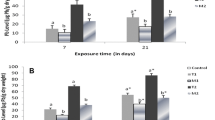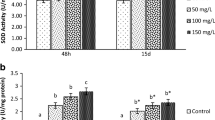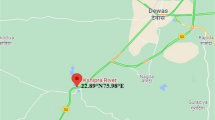Abstract
DNA damage (Comet assay), lipoperoxidation levels (TBARS), and several biomarkers of oxidative stress such as catalase (CAT), glutathione reductase (GR), glutathione peroxidase (GPx), glutathione S-transferase (GST), and contents of reduced (GSH) and total (TG) glutathione were measured in liver and blood (Comet assay) of tilapia (Oreochromis niloticus) exposed for 7, 15, 30 (subchronic exposure), 60, and 90 days (chronic exposure) to two treatment lagoons of a swine-processing plant, the first an anaerobic lagoon and the second a final treatment lagoon. After the 15th day, TBARS increased in fish exposed to both lagoons, decreased on the 30th day, and on the 90th day remained similar to controls. Fish exposed subchronically and chronically to both effluents showed consistently greater DNA damage. The CAT and GPx activities showed similar profiles and were induced only during the first week and during the first and second months. GST activity was induced throughout the experimental period. On the other hand, GR activities showed inverted profiles, with progressively decreased activities in the liver of fish exposed to the anaerobic lagoon, and progressively increased activities in fish exposed to the final lagoon. GSH showed higher contents in liver after 60 and 90 days of exposure to the final lagoon. GSSG contents were higher in fish exposed to the final lagoon throughout the experimental period. After 15 days, tilapia exposed to both lagoons showed enhanced total glutathione contents. The hepatic antioxidant system and biomarkers of oxidative stress such as DNA fragmentation and TBARS contents of tilapia exposed to both lagoons presented biphasic profiles. These changes in the antioxidant status also indicate that the industrial treatment is not adequate to avoid damaging environmental effects.



Similar content being viewed by others
References
Aebi H, (1984) Catalase In Vitro. Methods Enzymol. 105:121–126
Ahmad I, Hamid T, Fatima M, Chand HS, Jain SK, Athar M, Raisuddin S (2000) Induction of hepatic antioxidants in freshwater catfish (Channa puntactus bloch) is a biomarker of paper mill effluent exposure. Biochim Biophys Acta 1523:37–48
Almar MM, Diaz-Mayans J, Fernando MD, Nunez A, Romero FJ (1988a) Organ distribution of glutathione and some glutathione-related enzymatic activities in Procambarus clarkii: effect of sex, size and nutritional state. Comp Biochem Physiol 89:471–474
Associação Brasileira de Normas Técnicas (ABNT) (2003) Ensaio de toxicidade aguda com peixes: ensaio de ecotoxicologia, Projeto 00:001.044-001, Rio De Janeiro
Belpaeme K, Delbeke L, Zhu M, Kirsch-Volders (1996) Cytogenetic studies of PCB77 on brown trout Salmo trutta fario using the micronucleus test and the alkaline comet assay. Mutag 11(5):485–492
Bend JR, James MO (1978) Xenobiotic metabolism in marine and freshwater species. Biochem Biophys Perspect Mar Biol 4:125–130
Betti C, Nigro M (1996) The comet assay for the evaluation of the genetic hazard of pollutants in cetaceans: preliminary results on the genotoxic effects of methyl mercury on the bottlenosed dolphin Tursiops truncatus lymphocytes in vitro. Mar Poll Bull 32:545–548
Beutler E, Duran O, Kelly BM (1963) Improved method for the determination of blood glutathione. J Lab And Clin Med 61:882–890
Bird RP, Draper AH (1984) Comparative studies on different methods of malondialdehyde determination. Methods Enzymol 90:105–110
Black MC, Ferell JR, Horning RC, Martin LK (1996) DNA strand breakage in freshwater mussels (Anodonta grandis) exposed to lead in the laboratory and field. Environ Toxicol Chem 15:802–808
Calberg I, Mannervik B (1985) Glutathione reductase from rat liver. Methods Enzymol 113:484–490
Chevre N, Gagne F, Gagnon P, Blaise C (2002) Application of rough sets analysis to identify polluted aquatic sites based on a battery of biomarkers: a comparison with classical methods. Chemosphere 51:13–23
Chow CK; Hong CB (2002) Dietary vitamin E and selenium and toxicity of nitrite and nitrate. Toxicology 180:195–207
Ciccotelli M, Crippa S, Colombo A (1998) Bioindicators for toxicity assessment of effluents from a wastewater treatment plant. Chemosphere 37:2823–2832
Collins AR, Ma AG, Duthie SJ (1995) The kinetics of repair of oxidative DNA damage (strand breaks and oxidised pyrimidines) in human cells. Mutat Res 336:69–77
CONAMA (Conselho Nacional Do Meio Ambiente). (2003) Revisão da Resolução 020/86: sobre classificação e enquadramento de classes d’água, Brasília
Cosson RP, (2000) Bivalve metallothionein as a biomarker of aquatic ecosystem pollution by trace metals: limits and perspectives. Cell Mol Biol 46:295–309
Cotelle S, Férard JF (1999) Comet assay in genetic ecotoxicology: a review. Env Mol Mut 34:246–255
Depledge MH, Fossi MC (1994) The role of biomarkers in environmental assessment invertebrates. Ecotoxicology 3:161–172
Di Giulio RT, Habig C, Gallagher EP (1993) Effects of black rock harbour sediments on indices of biotransformation, oxidative stress and DNA integrity in channel catfish. Aquat Toxicol 26:1–22
Fatima M, Ahmad I, Sayeed I, Athar M, Raisuddin S (2000) Pollutant-induced over-activation of phagocytes is concomitantly associated with peroxidative damage in fish tissues. Aquat Toxicol 49:243–250
Flohé I, Gunzler WA (1984) Assays of glutathione peroxidase. Methods Enzymol 105:114–121
Fournier D, Bride JM, Poirie M (1992) Insect glutathione S-transferases biochemical characteristics of the major forms of houseflies susceptible and resistant to insecticides. J Biol Chem 267:1840–1845
Freeman BA, Crapo JD (1982) Biology of disease: free radicals and tissue injury. Lab Invest 47:412–426
Fridovich I, (1999) Fundamental aspects of reactive oxygen species, or what’s the matter with oxygen? Ann NY Acad Sci 893:13–18
Gallagher EP, Gross TS, Sheehy KM (2001) Decreased glutahione S-transferase expression and activity and altered sex steroids in Lake Apopka brown bullheads. Aquat Toxicol 55:223–237
Hai DQ, Varga SI, Matkovics B (1997) Organophosphate effects on antioxidant system of carp (Cyprinus carpio) and catfish (Ictalurus nebulosus). Comp Biochem Physiol 117c:83–88
Halliwell B, Gutteridge JMC (1999) Antioxidant defenses. In: Halliwell B, Gutteridge JMC (eds) Free Radicals in Biology and Medicine. Oxford Uinversity Press, New York, p 175
Hasspieler BM, Behar JV, Di Giulio RT (1994) Glutathione dependent defense in channel catfish (Ictalurus puntactus) and brown bulhead (Ameirus nebulosus). Ecotoxicol Environ Saf 28:82–90
Huang C, Chang R, Huang S, Chen W (2003) Dietary vitamin E supplementation affects tissue lipid peroxidation of hybrid tilapia, Oreochromis niloticus x O. aureus. Comp Biochem Physiol 134B:265–270
Kappus H, (1987) Oxidative stress in chemical toxicity. Arch Toxicol 60:144–149
Keen JH, Habig WH, Jakoby WB (1976) Mechanism for the several activities from glutathione S-transferase. J Biol Chem 251:6183–6188
Kirlin WG, Cai I, Thompson SA (1999) Glutathione redox potential in response to differentiation and enzyme inducers. Free Radic Biol Med 27:1208–1218
Kobayashi M, Rappaport E, Blasband A, Semeraro A, Sartore M, Surrey S, Fortina P (1995) Fluorescence-based DNA minisequence analysis of detection of known single-base changes in genomic DNA. Mol Cell Probes 9:175–182
Larsson DG, Kinnberg K, Sturve J (2002) Studies of masculinization, detoxification, and oxidative stress responses in guppies (Poecilia reticulata) exposed to effluent from a pulp mill. Ecotox Environ Saf 52:13–20
Lemaire P, Forlin L, Livingstone DR (1996) Responses of hepatic biotransformation and antioxidant enzymes to CYP1A-inducers (3-methylcholanthrene, b-naphthonavone) in sea bass (Dicentrarchus labrax), dab (Limanda limanda) and rainbow trout (Oncorhynchus mykiss). Aquat Toxicol 36:141–160
Lima PL, Benassi JC, Pedrosa RC, Wilhelm Filho D (2003) Detection of DNA damage in haemocytes of Mytella guaynensis mussel from two mangroves on Santa Catarina Island, Brazil, using comet assay. Genet Mol Biol 26/2:124
Lindesjoo E, Adolfsson-Erici M, Ericson G, Forlin L (2002) Biomarkers responses and resin acids in fish chronically exposed to effluents from a total chlorine-free pulp mill during regular production. Ecotox Environ Saf 53:238–247
Livingstone DR, (1998) The fate of organic xenobiotics in aquatic ecosystems: quantitative and qualitative differences in biotransformation by invertebrates and fish. Comp Biochem Physiol 120A:43–49
Maria VL, Correia AC, Santos MA (2003) Genotoxic and hepatic biotransformation responses induced by the overflow of pulp mill and secondary-treated effluents on Anguilla anguilla L. Ecotox Environ Saf 55:126–137
Nacci D, Nelson S, Nelson W, Jackim E (1992) Application of the DNA alkaline unwinding assay to detect DNA strand-breaks in marine bivalves. Mar Environ Res 33:83–100
Nigro M, Frenzilli G, Scarcelli V, Gorbi S, Regoli F (2002) Induction of DNA strand breakage and apoptosis in the eel Anguilla anguilla. Marin Environ Res 54:517–520
Ohkawa H (1979) Assay for lipid peroxides in animal tissues by thiobarbituric acid reaction. Anal Biochem 95:351–358
Oruç EO, Uner N (2000) Combined effects of 2,4-D and azinphosmethyl on antioxidant enzymes and lipid peroxidation in liver of Oreochromis niloticus. Comp Biochem Physiol 127c:291–296
Pandey S, Parvez S, Sayeed I, Rizwanul H, Bin-Hafez B, Raisuddin S (2003) Biomarkers of oxidative stress: a comparative study of river Yamuna fish Wallago attu (Bl. & Schn.). Sci Total Environ 309:105–115
Pandrangi R, Petras M, Ralph S, Vrzoc M (1995) Alkaline single cell gel (Comet) assay and genotoxicity monitoring using bullheads and carp. Environ Mol Mutag 26:345–356
Pedrosa RC, (1997) Effect of bleaching Eucalyptus pulp effluent from a Brazilian industry on the expression of cytochrome p4501A1 of tilapia (Oreochromis niloticus). Fifth Braz Symp Chem Lignins Wood Comp 449–453
Pedrosa RC, De Bem AF, Locatelli C, Pedrosa RC, Geremias R, Wilhelm Filho D (2001) Time-dependent oxidative stress caused by benznidazole. Redox Report 6:265–270
Ralph S, Petras M, Pandrangi M, Vrzoc M (1996) Alkaline single cell gel comet assay and genotoxicity monitoring using two species of tadpoles. Environ Mol Mutag 28/2:112–120
Ramelow GJ, Maples RS, Thompson RL, Mueller CS, Webre C, Beck JN (1987) Periphyton as monitors for heavy metal pollution in the Calcasieu River estuary. Environ Poll 43:247–261
Regoli F, Principato G (1995) Glutathione, glutathione-dependent antioxidant enzymes in mussel Mytilus galloprovincialis, exposed to metals. Aquatic Toxicol 31:143–164
Regoli F, Nigro M, Orlando E (1998) Lysosomal and antioxidant responses to metals in the Antarctic scallop Adamussium colhecki. Aquat Toxicol 40:375–392
Regoli F, Frenzilli G, Bocchetti R, Annarumma F, Scarcelli V, Fattorini D, Nigro M (2004) Time-course variations of oxyradical metabolism, DNA integrity and lysosomal stability in mussels, Mytilus galloprovincialis, during a field translocation experiment. Aquat Toxicol 68:167–178
Ribeiro L, Tribess T, Torres MA, Soares CHL, Pedrosa RC, Agostini J, Bueno A, Wilhelm Filho D (2000) Estresse oxidativo em tilápia (Oreochromis niloticus) exposta ao efluente de industria têxtil. In: Evaldo LGE, Clarice MRBP, Odete R, Maria BCB, Abílio LON (eds), Ecotoxicologia. São Carlos: Rima, p178
Rodriguez-Ariza AE, Dorado G (1991) Biochemical effects of environmental pollution in fishes from Spanish South-Atlantic littoral. Biochem Soc Trans 19:301s
Rodríguez-Ariza AE, Martínez-Lara E, Pascual P, Pedrajas JR, Abril N, Dorado G, Toríbio F, Bárcena JA, Peinado J, Pueyo C, López-Barea J (1993a) Biochemical and genetic indices of marine pollution in Spanish littoral. Sci Total Environ (suppl):109–116
Rodríguez-Ariza AE, Peinado J, Pueyo C, López-Barea J (1993b) Biochemical indicators of oxidative stress in fish from polluted littoral areas. Can J Fish Aquat Sci 50:2568–2573
Ross D, (1988) Glutathione, free radicals and chemotherapeutic agents: mechanisms of free-radical induced toxicity and glutathione-dependent protection. Pharmacol Ther 37:231–249
Sayeed I, Parvez S, Pandey S (2003) Oxidative stress biomarkers of exposure to deltamethrin in freshwater fish, Channa puntactus bloch. Ecotox Environ Saf 56:295–301
Silva AM, Novelli EL, Fascineli ML, Almeida JA (1999) Impact of an environmentally realistic intake of water contaminants and superoxide formation on tissues of rats. Environ Poll 105:243–249
Singh NP, McCoy MT, Tice RR, Schneider EL (1988) A simple technique for quantitation of levels of DNA damage in individual cells. Exp Cell Res 175:184–191
Stone KC, Hunt PG, Humenik FJ, Johnson MH (1998) Impact of swine waste application on ground and stream water quality in an eastern coastal plain watershed. Trans Asae 41:1665–1670
Tietze F, (1969) Enzymic method for quantitative determination of nanogram amounts of total and oxidized glutathione: applications to mammalian blood and other tissues. Anal Biochem 27:502–522
Torres MA, Testa CP, Gaspari C, Masutti MB, Panitz CM, Pedrosa RC, Almeida EA, Di Mascio PD, Wilhelm Filho D (2002) Oxidative stress in the mussel Mytella guyanensis from polluted mangroves on Santa Catarina Island, Brazil. Mar Poll Bull 44:923–932
Uhlig S, Wendel A (1992) The physiological consequences of glutathione variations. Life Sci 51:1083–1094
Wilhelm Filho D, (1996) Fish antioxidant defenses: A comparative approach. Braz J Med Biol Res 29:1735–1742
Wilhelm Filho D, Baptista IE, Soares CH, Pedrosa RC (1997) The effect of pulp mill effluent on two fish species. Fifth Braz Symp Chem Lignins Wood others Comp 612–619
Wilhelm Filho D, Torres MA, Marcon JL, Fraga CG, Boveris A (2000) Comparative antioxidant defenses in vertebrates: emphasis on fish and mammals. Comp Biochem Physiol 7:33–45
Wilhelm Filho D, Torres MA, Tribess TB, Pedrosa RC, Soares CH (2001) Influence of season and pollution on the antioxidant defenses of the cichlid fish acará (Geophagus brasiliensis). Braz J Med Biol Res 34:719–726
Wilhelm Filho D, Sell F, Ribeiro L, Ghisland M, Carrasquedo F, Fraga CG, Wallauer JP, Simões-Lopes PC, Uhart MM (2002) Comparison between the antioxidant status of terrestrial and diving mammals. Comp Biochem Physiol 133A:885–892
Zhang J, Shen H, Wang X, Wu J, Xue Y (2004) Effects of chronic exposure of 2,4-diclorophenol on the antioxidant system in liver of freshwater fish Carassius auratus. Chemosphere 55:167–174
Acknowledgments
P.L.L. and J.C.B. were recipients of CNPq-CTHidro scholarships and D.W.F. is a recipient of a research fellowship from CNPq (proc. 307485/2003-0).
Author information
Authors and Affiliations
Corresponding author
Rights and permissions
About this article
Cite this article
Lima, P.L., Benassi, J.C., Pedrosa, R.C. et al. Time-Course Variations of DNA Damage and Biomarkers of Oxidative Stress in Tilapia (Oreochromis niloticus) Exposed to Effluents From a Swine Industry. Arch Environ Contam Toxicol 50, 23–30 (2006). https://doi.org/10.1007/s00244-004-0178-x
Received:
Accepted:
Published:
Issue Date:
DOI: https://doi.org/10.1007/s00244-004-0178-x




